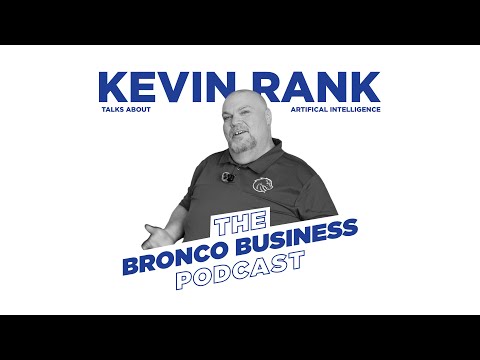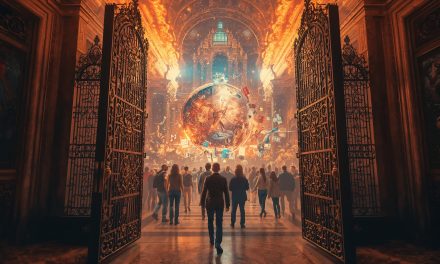I wanted to add a quick post about my time on the Bronco Business Podcast, hosted by Joe Morgan.
(Note: At the end of this post, I’ll do a small walk-through in how to use this podcast in NotebookLM)
Two months. That’s all it took.
We recorded a podcast about Generative AI when the semester started. Technical difficulties hit, we rescheduled, and by the time we reconnected, the entire conversation was obsolete. New models. New capabilities. New companies. The landscape had shifted so much that our original talking points felt like ancient history.
If you’re paying attention to AI & Generative AI right now, you know exactly what I’m talking about. That relentless feeling of the ground moving under your feet. People tell me all the time they feel like they’re trying to hold their ground against a tidal wave. It’s intimidating.
I’ve been riding waves of tech change since before the internet had a user-friendly interface. To me, this one feels different. But the fundamentals? Surprisingly familiar. You don’t need to know everything. You need to understand a few core principles about what AI actually is, how it works, and where it’s heading.
1. The Great Disruption is Also the Great Creation
Every technology that’s ever mattered cuts both ways. The printing press destroyed the scribe profession. It also handed humanity unprecedented access to information.
AI is the same… just more. A LOT more.
The World Economic Forum created a report earlier this year. AI will displace around 98 92 million jobs. But it’s projected to create roughly 128 170 million new ones. That’s a net gain, which matters. But it doesn’t mean the disruption isn’t real for the people in between. (Yea, my recollection of these numbers is off… but at least it is in the good way. Fewer jobs are projected to be lost, and more jobs added. 92 million jobs represents about 8% of the total current jobs.)
The report also says the 59% of workers will need to be retrained or upskilled… by 2030.
Look at what’s actually happening:
Accenture announced layoffs tied to AI. But the nuance matters. They’re reimagining their entire workflow, not just replacing people with bots. The positions getting cut are the ones that haven’t adapted to this new way of working. New roles? That’s a different story.
Klarna went all-in on AI customer service. Nine months later, they were rehiring customer reps. Turns out, people prefer talking to people. The real lesson here: AI isn’t a simple cost-cutting tool. It’s a revenue-enhancing one if you know how to use it.
2. You’re Probably Using It Wrong
We’ve been trained for 20+ years to think in search queries. AltaVista. Yahoo. Google. Type in keywords, get results. Simple.
That’s your biggest mental block with modern Generative AI.
LLMs aren’t search engines. They’re conversation engines. You get infinitely better results when you treat them like a back-and-forth dialogue instead of just dumping a prompt and walking away. That’s it. That one shift changes everything.
Also, and this is important, know when not to use it. AI isn’t the universal answer to every problem. Understand what it’s good at and what it’s terrible at. That’s just as valuable as knowing how to write a good prompt.
3. Your Life’s New Searchable User Manual
The best way to understand what AI can do is to use it.
Here are a few easy use-cases you can use.
Gather every instruction manual you can find for the stuff in your home, appliances, tools, the whole drawer full of incomprehensible booklets (You can find most manuals online, and can download them for this purpose). Throw them all into Google’s NotebookLM . Now you’ve got one searchable knowledge base for everything. Dishwasher acting weird? Just ask NotebookLM. No more digging through drawers. (Since this was recorded, sadly enough, my Dishwasher HAS been acting up… I am going to get a new dishwasher after work today. *sigh* NotebookLM and ChatGPT helped me troubleshoot and try numerous things. I spent about 2 hours last night testing water, how much water, etc. Finally traced it to a problem with heating. It will likely cost about as much to fix as the used dishwasher I found today).
One of my hobbies is 3D printing, and the manuals are… let’s call them “creatively translated.” Instead of trying to decipher broken English, I just take a picture and ask the AI what it actually means. Because it’s conversational, it gives you an interpretive translation—what the thing is trying to say—which beats a robotic word-for-word translation every time.
Want a silly one that actually works: See a flyer for an event? Take a picture with Gemini and say, “Add this to my calendar.” It extracts the details and drops it straight on your schedule. Done.
But the one that stuck with me, the host mentioned this during our podcast, he had to disassemble an iMac (a notoriously annoying task). Never done it before. He just snapped a picture of the guts with ChatGPT and asked, “Where’s the hard drive?” It found it and told him what size screwdriver he’d need.
4. The Most Important Skill Isn’t Technical
This one might catch you off guard.
Everyone assumes the future belongs to the people with the deepest tech skills. Wrong.
That same WEF report that mapped out job changes also identified the skills that’ll actually matter. The list was dominated by soft skills: continuous learning, grit, adaptability, communication. Not “advanced Python” or “machine learning frameworks.”
We have a phrase in IT for this: “drinking from the fire hose of knowledge.” Information comes at you faster than you can process it. You absorb a fraction and move on. That used to be unique to tech. Now? Everyone’s drinking from that hose.
When technical tasks get automated, what’s left is fundamentally human. Your ability to learn, adapt, and work with other people becomes your competitive advantage.
5. Generative AI as Your Personal Force Multiplier
Think of Generative AI as an amplifier, not a replacement.
It takes what you already know and makes you better at it. More efficient. More effective. But here’s the catch, you have to bring something to the table. Zero times anything is still zero. (Yeah, modern AI is good enough to create something decent from almost nothing, but to create something great? You need your own expertise in the mix.)
I do a lot of photography. Masking, selecting a person, sky, background to edit separately, used to be tedious, frame-by-frame work. Now Lightroom’s AI handles it perfectly in seconds. This didn’t replace me as a photographer. It killed the boring part, freeing me to focus on what actually makes the photo great. I get through a full shoot in a fifth of the time.
This also opens doors. My brother-in-law isn’t a musician, but he writes powerful lyrics. Using Generative AI, he can now create full compositions to go with them. Something completely out of reach before is now accessible.
The Real Takeaway
The best way to prepare for what’s coming is to play with it.
Expertise doesn’t come from reading about Generative AI. It comes from using it. Run a D&D campaign with it. Create music you can’t actually play. Organize your house. Take a picture of your food in the pantry and refrigerator and get a creative recipe. The more you experiment, the more you’ll actually understand its power and its limits. That’s how you ride the wave instead of getting swept away.
So here’s my question for you: What’s one thing in your daily life you could hand off to AI that would actually free you up to do something more interesting?
Using NotebookLM to “talk to” this podcast.
- Open NotebookLM and create a new notebook.
- Gather your resources to add.
- The YouTube video: https://www.youtube.com/watch?v=qkto3LehEZg
- Download PDF – The WEF Future of Jobs Report: https://www.weforum.org/publications/the-future-of-jobs-report-2025/
- In add sources, add the sources you gathered in the step above. Go down to link -> YouTube and insert the YouTube Link. Drag the PDF into Upload Sources (or click choose file).
- Now, you can start “Chatting” with the content of the Podcast, with the added information from the WEF Future of Jobs Report.
- Note: You can select what sources to reference, so you can uncheck the WEF report, and just chat with the podcast.
- Here are some things to try – Uncheck the WEF PDF file, so only the podcast is selected under sources:
- Create a MindMap (under studio).
- Create a Briefing Doc (Under Reports).
- Create a FAQ – Go to Reports, click Create Your Own, and then use this prompt:
- “Create a comprehensive FAQ with detailed and thorough answers that best captures the main themes and ideas in the sources. It should have a helpful tone designed to address reader inquiries.”


